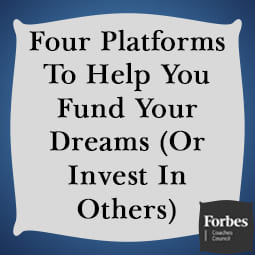Read this article on Forbes.com!
I don’t know about you, but every year I’ve had the same New Year’s resolutions: (1) Write a book, (2) lose 10 pounds, (3) find the love of my life,(4) fund the life of my dreams. And every year I ended my year without a new book, with love handles, and sometimes single, pining for how to fund my dream life.
That is, until the year that I wrote my fake obituary or DASH exercise. I realized then that if I didn’t start taking my New Year’s resolutions seriously, every new year would be the same. Now I’ve written two books and been featured in various columns. I’ve shed over 25 pounds. I’m still searching for The One, but hey, that will happen when the time is right.
But I have funded my way around the world twice in three years. If you’re looking for ways to fund your dreams or become an investor yourself, here are four platforms to consider based on my own and my coaching clients’ experiences.
Kickstarter
Kickstarter is a well-known option for artists and creatives to kickstart their latest projects.
One of the most successful campaigns was 99% Invisible, a radio show about what we don’t think about and how our world is shaped by design. It started as a podcast from Roman Mars’ bedroom and was picked up by public radio as his followers continued to grow. Roman and his team have kickstarted more than $1.1 million in four Kickstarter campaigns.
But 99% Invisible is an anomaly, according to Kickstarter’s website stats: 210,918 campaigns are unfunded or more than 50%. With fill or kill options, you either reach your goal and get 100% funded or walk away empty handed.
To be successful on Kickstarter one must have a large engaged, supportive network. One mistake many make on Kickstarter is setting your monetary goals too high for your first campaign.
Indiegogo
While Kickstarter attracts more artists, one should consider using Indiegogo if you are looking to fund a new business.
Unlike Kickstarter, Indiegogo offers flexible funding, which means that you can keep the money you raise, whether or not you hit your goal.
One new feature is that Indiegogo now supports nonprofits, and socially minded campaigns enjoy a 0% platform fee on Generosity. Also, it supports crowdfunding campaigns in several different currencies.
SeedInvest
SeedInvest helps connect tech scalable startups with investors online. As such, SeedInvest is a good option for those who are high net worth individuals and understand financial and legal ramifications of equity investing.
As a result of the JOBS Act and the work of the SEC and FINRA, SeedInvest and other market participants can now raise up to $50 million from investors under Regulation A+, which went into effect June 19, 2015.
SeedInvest has helped fund over 65 high-growth technology based startups with an average investment of $500,000.
I joined SeedInvest in 2014 as an equity crowdfunder when the platform was still working out different bugs. Now there are more startups with contributions as low as $100 per investor. Although anyone can join to diversify your investments, and invest in the next unicorn, do your due diligence before investing.
Kiva
Kiva is an international nonprofit with a mission to connect people through lending to alleviate poverty. By giving $25+ on Kiva, lenders can help borrowers start or expand a business or nonprofit organization, or even a farm.
Based on the multiplier effect, Kiva is another crowdfunding platform that has loaned $935 million to 2.3 million borrowers through 1.6 million lenders. Borrowers tend to be aspiring farmers, food producers, makers, services, and social enterprises.
One of my clients, Kimberly, desired to start her own nonprofit organization to teach leadership skills through dance to 5-18-years-olds. After taking my company’s #StartMyBusinessToday Program, Kimberly raised $5,000 for her new profit-organization Move UP! in 20 days with the support of 164 Kiva funders.
Kiva is also a fill or kill platform with 100% of every dollar lent on Kiva going to funding loans. It is also in 82 countries, lending money through community organizations.
On Kiva, 90% of public campaigns are successfully funded with no special requirements for lenders. Kiva funds on character, not credit, which is why it is popular with startups, farm to fork, and pre-revenue brick-and-mortar service small businesses. What’s more, Kiva’s lender community typically funds 70-80% of campaigns, whereas on other crowdfunding sites you’re expected to raise at least that much from your own network.
What’s the best way for you to fund your new year’s dreams?


